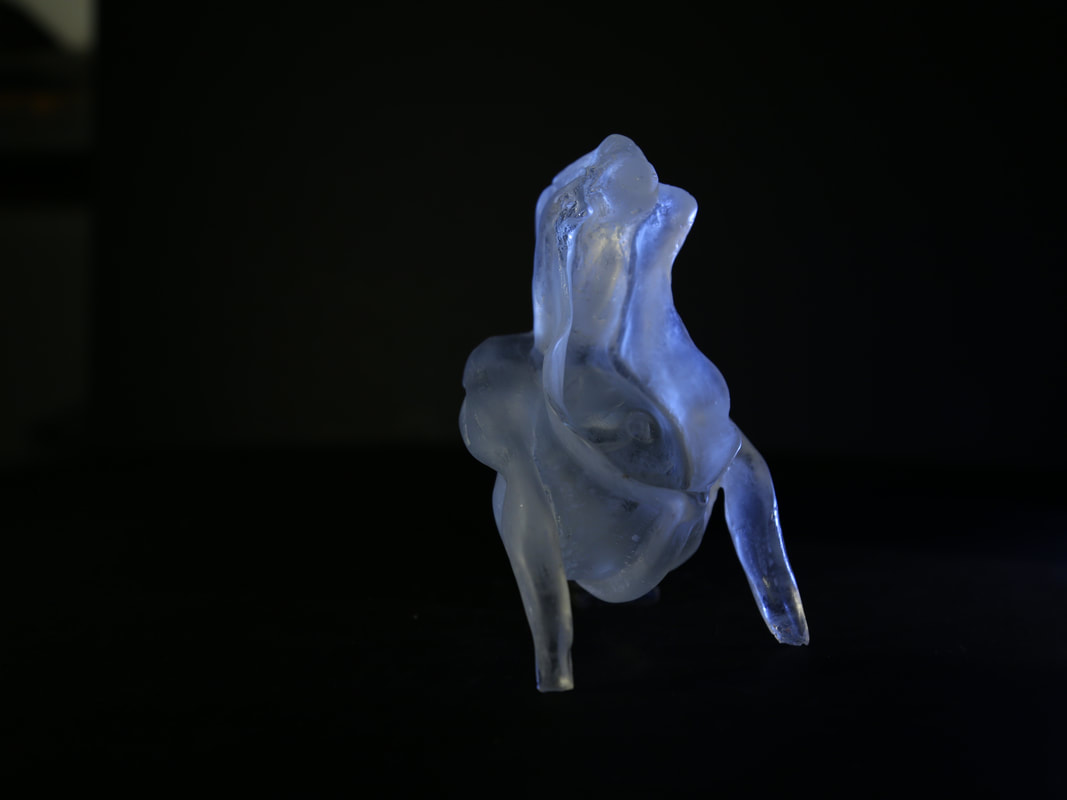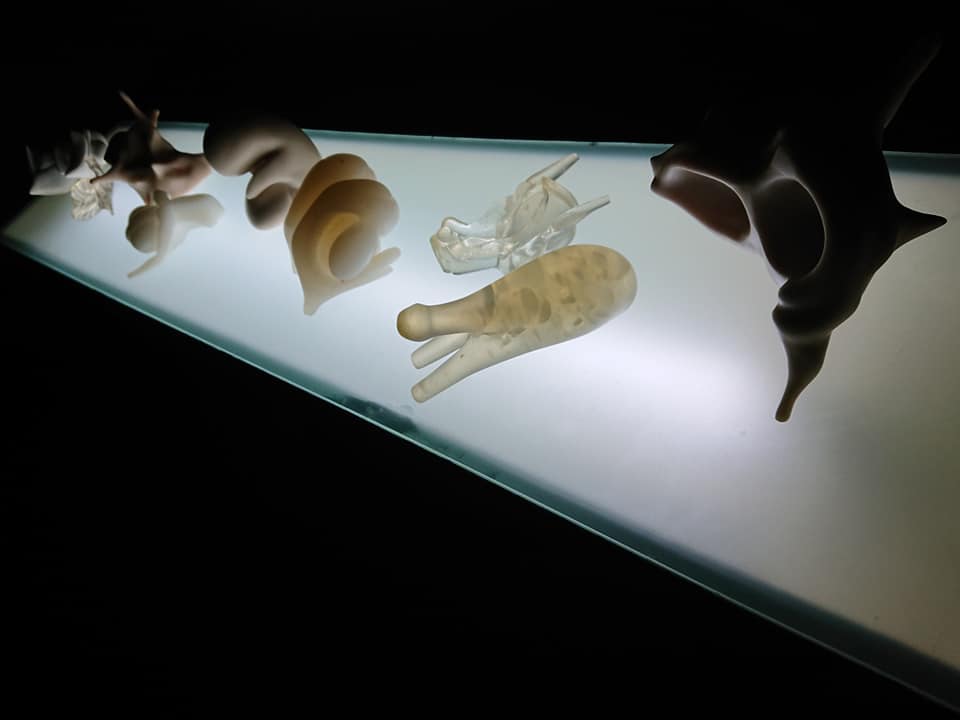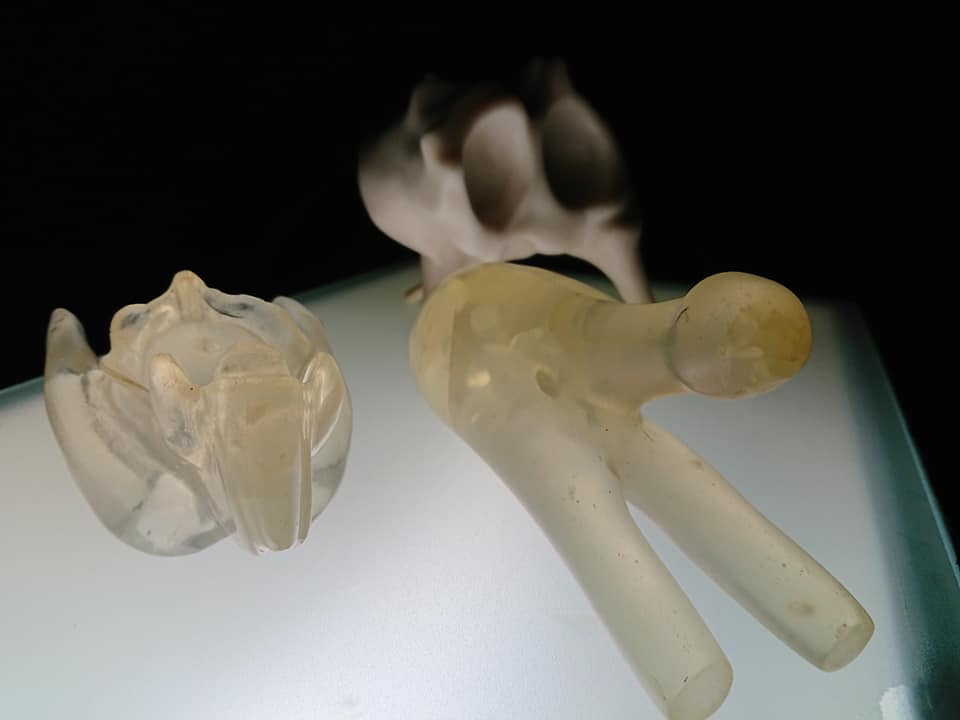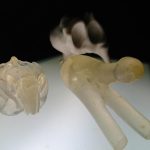For his first exhibition at the gallery Sherif El Azma presents a body of sculptural work made in old Cairo, at his Fustat studio. An ongoing project that investigates material forms, material histories, renegotiations of symbolic language, offering, ritual and alternative hypothetical stories told with the object as the central nucleus for discussion. This complex exhibition encompasses the production of sculptural, textual and photo works within an ongoing process to build a more concise multimedia presentation of various concepts and ideas on the representation of history, fiction and mythology building through art mediums.
Belly of a Mountain: Offerings and Plaques (2014-2020)
Objects, sculpture, 2-dimensional relief, tabletop relief (tray works), serial objects conceived and created in Fustat, Old Cairo.
A) The trays (hard plastics, polyester resins, calcium, 120×80, 40×28)
The tray functions as an ‘offering;' in waking life, carrying, classifying, presenting and at other levels narrating (as an interface that can contain visual syntax, where ideas form a narrative of sorts). The negative empty space of the tray imagines content, value, need and urgencies. The compartments, empty spaces allocated on the medium of the tray suggest needs by combination (as words form sentences, arguments or narratives).
This is quite evident from the larger 'story trays' that keep its contents within compartments, where the interface is authored/ created. Another group in the series simulates the ancient language of Greco-Roman offering tables/ trays present in the Egyptian museum. The pieces are processed to the ergonomic standards and industrial standardization of contemporary usage. Here the object is monumentalized and takes on another presence where function is kept dogmatically physical. Materiality here plays the part of a facilitator of
ritual, repetitive action, smooth mechanics and sterilization.
The offerings and their ergonomic designs have become keepers of the refinement and reinvestigation of basic architectural and spatial organization, both in the ritual of commemoration, dwelling and death rituals. These spaces are offered as polar possibilities in the subversion of ritual through architecture. Here the trays offer the possibilities of containment by the interplay of positive and negative space.

B) The plaques (polyester resin and natural pigment and powders, 100 x 80cm)
In Roman times, a plaque was a stone that was an integral part of the foundation of a building, usually a public building of significance in governing or religious community.
The plaque was usually a carved relief in stone, and later in plaster or fresco; most of such ancient signage in Rome did not include language except over the different eras of the Roman imperial expansion; a common, and standardized basic lexicon or hieroglyph was tentatively used. A butcher had an ox; the tavern had barley stalk etched. These plaques went on to ‘commemorate’ more subjective messages from their users, where the deciphering of the standardized lexicon becomes reused, reshaped, edited, and simplified further according to the urgency of producer of the message. Here the symbol is deconstructed and suggested before an imaginary process of translation.
The sentences evoke themes of human/spiritual offering, guilt, acceptance, mourning and longing.

C) The order of forms… sculptures, statuettes in series of 5 or 7 ((polyester, epoxy, light boxes)
The collection of small sculptures where developed over a long period of drawings, morphing, re-morphing and the different processes of casting and finishing resins using experiments in the ingredient of pigment, crystallization and sediment. These processes which are considered geo-evolutionary in earth, and in turn inspired the alchemical use of silica, calcium, pressures and different temperature to form stone like, crystal and even bone-like structures; found in the formations around local geographies.
The production of the pieces was executed in collaboration with a team of sculptors and finishers, through negotiation with the craftsperson or in a more leniently controlled finishing process, which smoothens and often disturbs the nuances of the original sculpting. Mistakes or abrasions in the process helped re-morph the drawings in a more sculptural manner, and over time a balance of aesthetic fixation in sculptural language was developed. The different bio-systems and shapes were the studies of essential organs in the reproduction, and interaction of carnal desire in select plant and animal systems. In the end, such an extensive study in form and careful physical morphing created a deity of character
statuettes that exist as palm sized forgotten objects of frustrated desire.

D) Monuments in bronze (in progress)
Some of the lexicons' residue had cast themselves into bronze monuments commemorating rituals, or the mysterious presence of metaled bio forms as commemorative icons.

Sherif El Azma
Born in Manchester, U.K, 1975. Works and lives in Cairo. Sharif El Azma graduated from the Surrey Institute of Art and Design, University College in the U.K. in 1997.
From 1997 until 2010 he was actively involved in filmmaking and video art production with works ranging from experimental documentaries earlier in his career to experimental film and multimedia installation with video and expanded cinema. From 2014 he has been producing objects, sculpture and installation in Cairo as his career takes a turn towards to building multi-media and sculptural presentations. El Azma has been mentoring a generation of young video producers for younger artists through self-organized production labs, workshops and as an instructor at the American University in Cairo since 2008. El Azma’s video and art works appeared at the Townhouse Gallery, Cairo; Pacific Film Archive, Berkley Calif.; World Wide video festival, Amsterdam; Transmediale, Berlin; Kunsthaus Bethannien, Berlin; Sharjah Biennial, ACAF Alexandria, Art Lab Berlin, Funen Art Akademie, Video Brazil in São Paolo, Brazil; Ashkal Alwan, Beirut; Rotterdam Film Festival, Art Dubai, and others.




